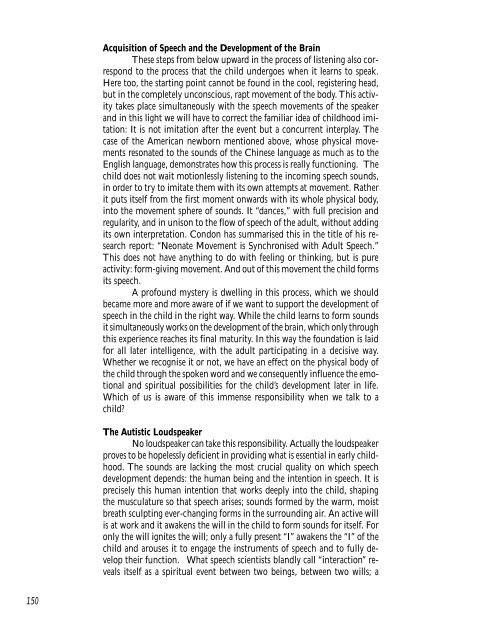Colloquium on English - Research Institute for Waldorf Education
Colloquium on English - Research Institute for Waldorf Education
Colloquium on English - Research Institute for Waldorf Education
Create successful ePaper yourself
Turn your PDF publications into a flip-book with our unique Google optimized e-Paper software.
150<br />
Acquisiti<strong>on</strong> of Speech and the Development of the Brain<br />
These steps from below upward in the process of listening also corresp<strong>on</strong>d<br />
to the process that the child undergoes when it learns to speak.<br />
Here too, the starting point cannot be found in the cool, registering head,<br />
but in the completely unc<strong>on</strong>scious, rapt movement of the body. This activity<br />
takes place simultaneously with the speech movements of the speaker<br />
and in this light we will have to correct the familiar idea of childhood imitati<strong>on</strong>:<br />
It is not imitati<strong>on</strong> after the event but a c<strong>on</strong>current interplay. The<br />
case of the American newborn menti<strong>on</strong>ed above, whose physical movements<br />
res<strong>on</strong>ated to the sounds of the Chinese language as much as to the<br />
<strong>English</strong> language, dem<strong>on</strong>strates how this process is really functi<strong>on</strong>ing. The<br />
child does not wait moti<strong>on</strong>lessly listening to the incoming speech sounds,<br />
in order to try to imitate them with its own attempts at movement. Rather<br />
it puts itself from the first moment <strong>on</strong>wards with its whole physical body,<br />
into the movement sphere of sounds. It “dances,” with full precisi<strong>on</strong> and<br />
regularity, and in unis<strong>on</strong> to the flow of speech of the adult, without adding<br />
its own interpretati<strong>on</strong>. C<strong>on</strong>d<strong>on</strong> has summarised this in the title of his research<br />
report: “Ne<strong>on</strong>ate Movement is Synchr<strong>on</strong>ised with Adult Speech.”<br />
This does not have anything to do with feeling or thinking, but is pure<br />
activity: <strong>for</strong>m-giving movement. And out of this movement the child <strong>for</strong>ms<br />
its speech.<br />
A profound mystery is dwelling in this process, which we should<br />
became more and more aware of if we want to support the development of<br />
speech in the child in the right way. While the child learns to <strong>for</strong>m sounds<br />
it simultaneously works <strong>on</strong> the development of the brain, which <strong>on</strong>ly through<br />
this experience reaches its final maturity. In this way the foundati<strong>on</strong> is laid<br />
<strong>for</strong> all later intelligence, with the adult participating in a decisive way.<br />
Whether we recognise it or not, we have an effect <strong>on</strong> the physical body of<br />
the child through the spoken word and we c<strong>on</strong>sequently influence the emoti<strong>on</strong>al<br />
and spiritual possibilities <strong>for</strong> the child’s development later in life.<br />
Which of us is aware of this immense resp<strong>on</strong>sibility when we talk to a<br />
child?<br />
The Autistic Loudspeaker<br />
No loudspeaker can take this resp<strong>on</strong>sibility. Actually the loudspeaker<br />
proves to be hopelessly deficient in providing what is essential in early childhood.<br />
The sounds are lacking the most crucial quality <strong>on</strong> which speech<br />
development depends: the human being and the intenti<strong>on</strong> in speech. It is<br />
precisely this human intenti<strong>on</strong> that works deeply into the child, shaping<br />
the musculature so that speech arises; sounds <strong>for</strong>med by the warm, moist<br />
breath sculpting ever-changing <strong>for</strong>ms in the surrounding air. An active will<br />
is at work and it awakens the will in the child to <strong>for</strong>m sounds <strong>for</strong> itself. For<br />
<strong>on</strong>ly the will ignites the will; <strong>on</strong>ly a fully present “I” awakens the “I” of the<br />
child and arouses it to engage the instruments of speech and to fully develop<br />
their functi<strong>on</strong>. What speech scientists blandly call “interacti<strong>on</strong>” reveals<br />
itself as a spiritual event between two beings, between two wills; a

















